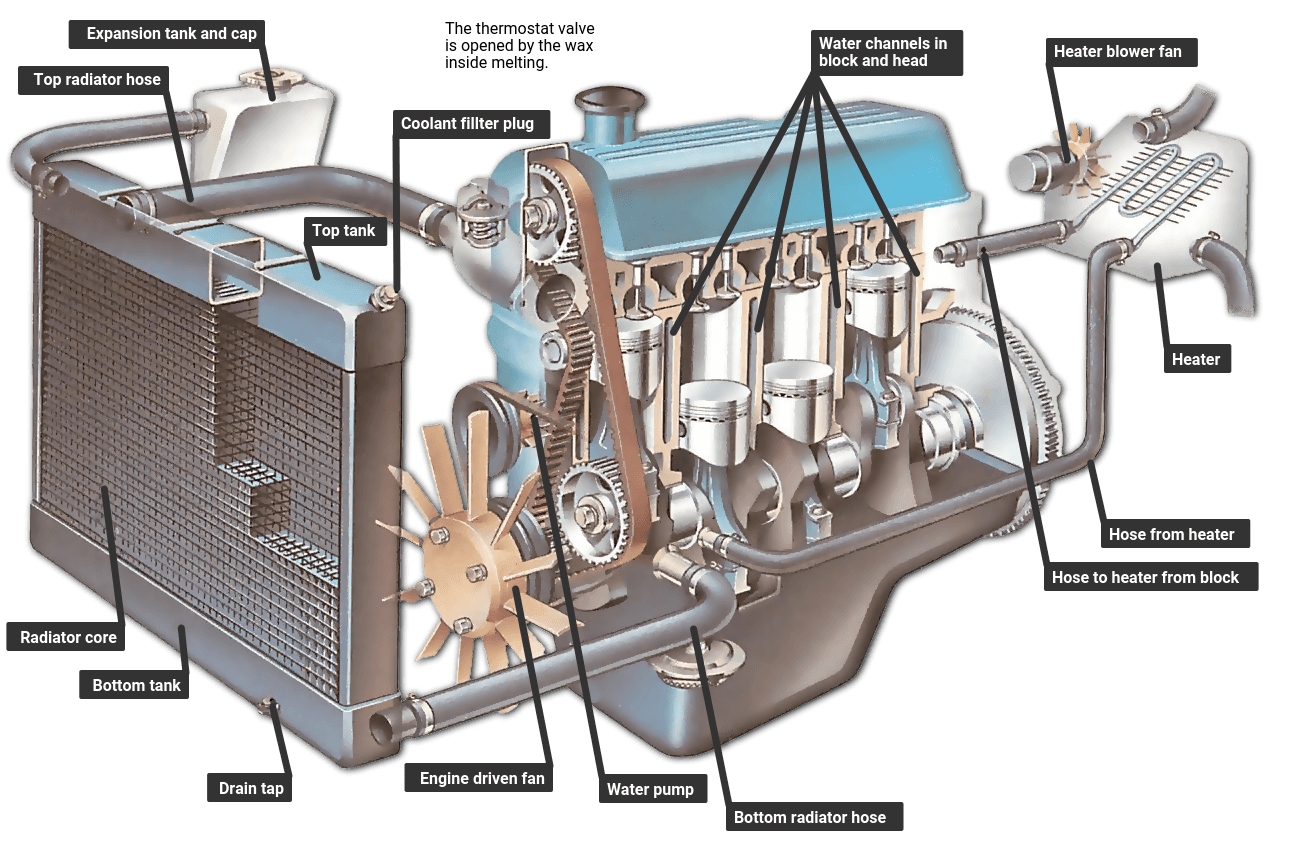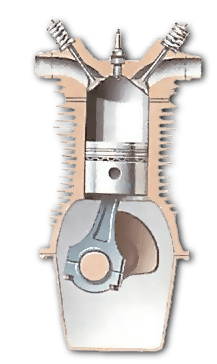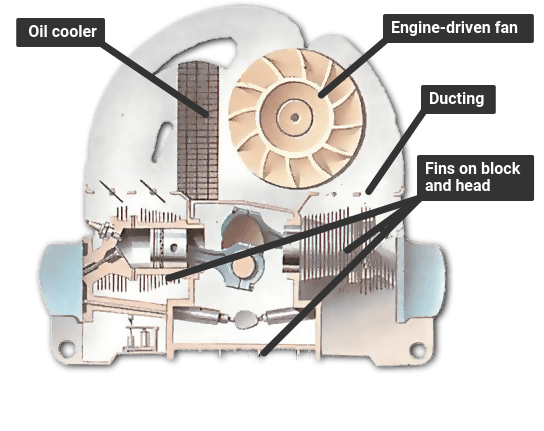How an engine cooling system works
The Video Course teaches you everything about modern cars.
A car engine produces a lot of heat when it is running, and must be cooled continuously to avoid engine damage.
Generally this is done by circulating coolant liquid usually water mixed with an antifreeze solution through special cooling passages. Some engines are cooled by air flowing over finned cylinder casings.

A water-cooled cooling system
A water-cooled engine block and cylinder head have interconnected coolant channels running through them. At the top of the cylinder head all the channels converge to a single outlet.
A pump , driven by a pulley and belt from the crankshaft , drives hot coolant out of the engine to the radiator , which is a form of heat exchanger .
Unwanted heat is passed from the radiator into the air stream, and the cooled liquid then returns to an inlet at the bottom of the block and flows back into the channels again.
Usually the pump sends coolant up through the engine and down through the radiator, taking advantage of the fact that hot water expands, becomes lighter and rises above cool water when heated. Its natural tendency is to flow upwards, and the pump assists circulation.
The radiator is linked to the engine by rubber hoses , and has a top and bottom tank connected by a core a bank of many fine tubes.
The tubes pass through holes in a stack of thin sheet-metal fins, so that the core has a very large surface area and can lose heat rapidly to the cooler air passing through it.
On older cars the tubes run vertically, but modern, low-fronted cars have crossflow radiators with tubes that run from side to side.
In an engine at its ordinary working temperature, the coolant is only just below normal boiling point.
The risk of boiling is avoided by increasing the pressure in the system, which raises the boiling point.
The extra pressure is limited by the radiator cap, which has a pressure valve in it. Excessive pressure opens the valve, and coolant flows out through an overflow pipe.
In a cooling system of this type there is a continual slight loss of coolant if the engine runs very hot. The system needs topping up from time to time.
Later cars have a sealed system in which any overflow goes into an expansion tank , from which it is sucked back into the engine when the remaining liquid cools.
How the fan helps
The radiator needs a constant flow of air through its core to cool it adequately. When the car is moving, this happens anyway; but when it is stationary a fan is used to help the airflow.
The fan may be driven by the engine, but unless the engine is working hard, it is not always needed while the car is moving, so the energy used in driving it wastes fuel .
To overcome this, some cars have a viscous coupling a fluid clutch worked by a temperature sensitive valve that uncouples the fan until the coolant temperature reaches a set point.
Other cars have an electric fan, also switched on and off by a temperature sensor .
To let the engine warm up quickly, the radiator is closed off by a thermostat , usually sited above the pump. The thermostat has a valve worked by a chamber filled with wax.
When the engine warms up, the wax melts, expands and pushes the valve open, allowing coolant to flow through the radiator.
When the engine stops and cools, the valve closes again.
Water expands when it freezes, and if the water in an engine freezes it can burst the block or radiator. So antifreeze usually ethylene glycol is added to the water to lower its freezing point to a safe level.
Antifreeze should not be drained each summer; it can normally be left in for two or three years.
Air-cooled engine cooling systems
In an air-cooled engine, the block and cylinder head are made with deep fins on the outside.



Frequently a duct runs all around the fins, and an engine-driven fan blows air through the duct to take heat away from the fins.
A temperature-sensitive valve controls the amount of air being pushed around by the fan, and keeps the temperature constant even on cold days.
Cooling the oil
The Ultimate Car Mechanics video course
Learn everything about modern cars from our new video series.
Learn more >-
We build a Mazda MX5 Miata from scratch
We start by tearing down and then rebuilding the whole car.
-
Every part explained
There's ridiculous detail on every part. Clearly and easily explained.
-
All modeled in 3D
We've created the most detailed 3D model ever produced so we can show you everything working.






